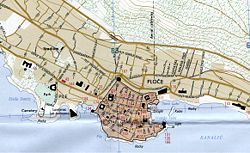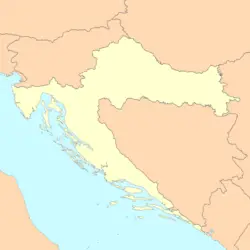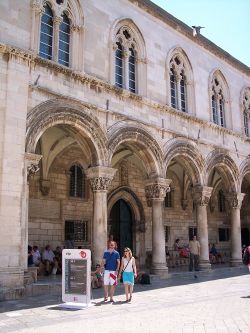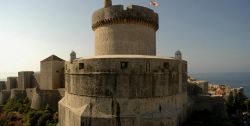Difference between revisions of "Dubrovnik" - New World Encyclopedia
Mike Butler (talk | contribs) |
Mike Butler (talk | contribs) |
||
| Line 147: | Line 147: | ||
The Dubrovnik Region has a typical [[Mediterranean]] climate, with mild, rainy winters and hot and dry summers. However, the [[Bora]] wind blows uncomfortably cold gusts down the [[Adriatic]] coast between October and April, and thundery conditions are common all the year round. In July, daytime maximum temperatures reach 84°F (29°C), and in January drop to 54°F (12°C). Mean annual precipitation is 51 inches (1298mm). | The Dubrovnik Region has a typical [[Mediterranean]] climate, with mild, rainy winters and hot and dry summers. However, the [[Bora]] wind blows uncomfortably cold gusts down the [[Adriatic]] coast between October and April, and thundery conditions are common all the year round. In July, daytime maximum temperatures reach 84°F (29°C), and in January drop to 54°F (12°C). Mean annual precipitation is 51 inches (1298mm). | ||
| − | A striking feature of Dubrovnik is its walls that run 1.2 miles (2km) around the city. The walls run from 13 to 20 feet (four to six meters) thick on the landward side but are much thinner on the seaward side. The system of turrets and towers were intended to protect the vulnerable city but now make one of the most picturesque sights in the Adriatic.<ref>[http://www.croatiatraveller.com/southern_dalmatia/Dubrovnik/dubrovnik_index.htm Croatia Traveller, Dubrovnik]</ref> | + | A striking feature of Dubrovnik is its walls that run 1.2 miles (2km) around the city, and reach a height of about 80 feet (25 meters). The walls run from 13 to 20 feet (four to six meters) thick on the landward side but are much thinner on the seaward side. The system of turrets and towers were intended to protect the vulnerable city but now make one of the most picturesque sights in the Adriatic.<ref>[http://www.croatiatraveller.com/southern_dalmatia/Dubrovnik/dubrovnik_index.htm Croatia Traveller, Dubrovnik]</ref> |
The plan of the old city, which is a maze of picturesque streets, dates from 1292. The Stradun, or main street, is lined with Renaissance houses, and runs along a once marshy valley. A 14th-century Franciscan convent guards the western gate, while a Dominican convent stands by the eastern gate. The 15th century late Gothic style Rector’s Palace, was the seat of government of the Dubrovnik Republic. | The plan of the old city, which is a maze of picturesque streets, dates from 1292. The Stradun, or main street, is lined with Renaissance houses, and runs along a once marshy valley. A 14th-century Franciscan convent guards the western gate, while a Dominican convent stands by the eastern gate. The 15th century late Gothic style Rector’s Palace, was the seat of government of the Dubrovnik Republic. | ||
Revision as of 22:01, 19 September 2008
| ||||||||||||||||||||||||||||||||||||||||||||
File:Old City, Dubrovnik.jpg Rooftops in Dubrovnik's Old City, a UNESCO World Heritage Site. | ||||||||||||||||||||||||||||||||||||||||||||
 Dubrovnik bridge of Franjo Tuđman and the Port of Gruž | ||||||||||||||||||||||||||||||||||||||||||||
Dubrovnik (IPA: [ˈdǔ.bro̞ːʋ.niːk]; Dalmatian: Ragusa; Latin: Ragusium, also Rhausium, Rhaugia; Italian: Ragusa) is a city on the Adriatic Sea coast in the extreme south of Croatia. Regarded as the most picturesque city on the Dalmatian coast, it is one of the most prominent tourist destinations on the Adriatic, a seaport and the centre of Dubrovnik-Neretva county.
In 1979, the city of Dubrovnik joined the UNESCO list of World Heritage Sites.
The prosperity of the city of Dubrovnik has always been based on maritime trade. In the Middle Ages, as the Republic of Ragusa, it became the only eastern Adriatic city-state to rival Venice. Supported by its wealth and skilled diplomacy, the city achieved a remarkable level of development, particularly during the 15th and 16th centuries. Ragusa was one of the centres of the development of primarily the Croatian language and literature, home to many notable poets, playwrights, painters, mathematicians, physicists and other scholars.
Geography
The Slavic toponym Dubrovnik originates from the Proto-Slavic term for an oak forest *dǫbrava or *dǫbrova (dubrava in archaic and literary Croatian), which was abundantly present in the hills north of the walled city of Dubrovnik by the end of the 11th century. The current name was officially adopted in 1909, when the city was under Austro-Hungarian rule.
Positioned at the terminal end of the Isthmus of Dubrovnik, the city is located on a promontory jutting into the sea under the bare limestone Mount Srdj.
The Dubrovnik Region has a typical Mediterranean climate, with mild, rainy winters and hot and dry summers. However, the Bora wind blows uncomfortably cold gusts down the Adriatic coast between October and April, and thundery conditions are common all the year round. In July, daytime maximum temperatures reach 84°F (29°C), and in January drop to 54°F (12°C). Mean annual precipitation is 51 inches (1298mm).
A striking feature of Dubrovnik is its walls that run 1.2 miles (2km) around the city, and reach a height of about 80 feet (25 meters). The walls run from 13 to 20 feet (four to six meters) thick on the landward side but are much thinner on the seaward side. The system of turrets and towers were intended to protect the vulnerable city but now make one of the most picturesque sights in the Adriatic.[1]
The plan of the old city, which is a maze of picturesque streets, dates from 1292. The Stradun, or main street, is lined with Renaissance houses, and runs along a once marshy valley. A 14th-century Franciscan convent guards the western gate, while a Dominican convent stands by the eastern gate. The 15th century late Gothic style Rector’s Palace, was the seat of government of the Dubrovnik Republic.
History
Roman refugees fleeing the Slav and Avar sack of the nearby city of Epidaurus, today's Cavtat, founded Ragusa (Raugia) about 614 C.E. on a rocky island named Laus. Some time later a settlement of Slavic people grew at the foot of the forested Srđ hill. This settlement gives to the city its Slavic name "Dubrovnik". From that time, Dubrovnik was under Byzantine Empire protection.
The strip of wetland between Ragusa and Dubrava was reclaimed in the 12th century, unifying the city around the newly-made plaza (today Placa or Stradun). After the Crusades, Ragusa/Dubrovnik came under the sovereignty of Venice (1205–1358).
As a port located on overland trade routes to Byzantium and the Danube region, trade flourished. The Republic of Ragusa adopted Statutes, as early as 1272, which codified Roman practice and local customs, and provided for town planning. Between the 14th century and 1808, Ragusa ruled itself as a free state. A medical service was introduced in 1301, the first pharmacy (still working) was opened in 1317, and a refuge for old people was opened in 1347.
By the Peace Treaty of Zadar in 1358, Ragusa became part of the Hungaro-Croatian reign. The city’s first quarantine hospital (Lazarete) was opened in 1377, slave trading was abolished in 1418, the orphanage was opened in 1432 , and the water supply system (20 kilometers) was constructed in 1436.
The city was ruled by aristocracy that formed two city councils. As usual for the time, they maintained a strict system of social classes. The republic abolished the slave trade early in the 15th century and valued liberty highly. The city successfully balanced its sovereignty between the interests of Venice and the Ottoman Empire for centuries.
The economic wealth of the Republic was partially the result of the land it developed, but especially of the seafaring trade it did. With the help of skilled diplomacy, Ragusa's merchants traveled lands freely, and on the sea the city had a huge fleet of merchant ships (argosy) that traveled all over the world. From these travels they founded some settlements, from India to America, and brought parts of their culture and vegetation home with them. One of the keys to success was not conquering, but trading and sailing under a white flag with the word freedom (Latin: Libertas) prominently featured on it. That flag was adopted when slave trading was abolished in 1418.
The Republic gradually declined after a crisis of Mediterranean shipping — and especially a catastrophic earthquake in 1667 that killed over 5000 citizens, including the Rector, leveling most of the public buildings — ruined the well-being of the Republic. In 1699 the Republic sold two patches of its territory to the Ottomans to avoid terrestrial borderline, with advancing Venetian forces. Today this strip of land belongs to Bosnia and Herzegovina and is its only direct access to the Adriatic.
In 1806, the city surrendered to French forces, as that was the only way to cut a month's long siege by the Russian-Montenegrin fleets (during which 3000 cannonballs fell on the city). In 1808, Marshal Marmont abolished the republic and integrated its territory into the Illyrian provinces.
When the Habsburg Empire gained these provinces after the 1815 Congress of Vienna, the new imperial authorities installed a bureaucratic administration, which retained the essential framework of the Italian-speaking system. In 1815, the former Ragusan Government, i.e. its noble assembly, met for the last time in the ljetnikovac in Mokošica.
In 1848, the Croatian Assembly (Sabor) published People's Requests in which they requested among other things abolition of serfdom and the unification of Dalmatia with rest of Croatian lands (primarily with Austro-Hungarian Kingdom of Croatia). Dubrovnik municipality was the most outspoken of all Dalmatian communes in its support for unification with Croatia.
With fall of Austria-Hungary in 1918 after World War I, the city was incorporated into the new Kingdom of Serbs, Croats, and Slovenes (later the Kingdom of Yugoslavia). The name of the city was officially changed from Ragusa to Dubrovnik.
In World War II (1939-1945), Dubrovnik became part of the Nazi puppet Independent State of Croatia, occupied by an Italian army first, and by a German army after September 1943. In October 1944 Tito's partisans entered Dubrovnik, that became consequently part of Communist Yugoslavia. Soon after their arrival into the city, Partisans sentenced approximately 78 citizens to death without trial, including a Catholic priest.
In 1991 Croatia and Slovenia, which at that time were republics within Socialist Federal Republic of Yugoslavia, declared their independence. At that event, Socialist Republic of Croatia was renamed Republic of Croatia.
On October 1, 1991 Dubrovnik was attacked by JNA with a siege of Dubrovnik that lasted for seven months. Heaviest artillery attack happened on December 6 with 19 people killed and 60 wounded. Total casualties in the conflict according to Croatian Red Cross were 114 killed civilians, among them celebrated poet Milan Milisić. In May 1992 the Croatian Army liberated Dubrovnik and its surroundings, but the danger of sudden attacks by the JNA lasted for another three years. General Pavle Strugar, who was coordinating the attack on the city, was sentenced to an eight year prison term by the International Criminal Tribunal for the former Yugoslavia for his role in the attack of the city.
The 1996 Croatia USAF CT-43 crash killed everyone on a United States Air Force jet with VIP passengers.
Government
Croatia is a parliamentary democracy in which the president is chief of state, and is elected by popular vote for a five-year term (eligible for a second term). The prime minister is head of government, who, as leader of the majority party, is appointed by the president and approved by the Assembly. The unicameral Assembly, or Sabor, comprises 153 members elected from party lists by popular vote to serve four-year terms.
Dubrovnik is the administrative center of Dubrovnik-Neretva county, which is one of Croatia's 20 counties (županijas). Dubrovnik-Neretva county is divided into five cities and 17 municipalities. The county assembly comprises 41 representatives, and was presided over by Nikola Obuljen in 2008. Counties are regional self-government units with limted responsibility for education, health service, area and urban planning, economic development, traffic and traffic infrastructure and the development of network of educational, health, social and cultural institutions.
Municipalities and towns are local self-government units responsible for housing, area and urban planning, public utilities, child care, social welfare, primary health services, education and elementary schools, culture, physical education and sports, customer protection, protection and improvement of the environment, fire protection and civil defence.
Economy
Croatia's economic fortunes have began to improve since 2000, led by a rebound in tourism and credit-driven consumer spending. A high unemployment rate (of 11.8 percent in 2007) , a growing trade deficit, and uneven regional development pose challenges. Tourism and the port are the basis of Dubrovnik's economy, and there are some light industries. Croatia's per capita GDP was estimated at $US15,500 in 2007.
Rail lines connect Dubrovnik directly to neighbouring countries. Dubrovnik Airport, located approximately 12 miles (20km) from the city center, near Ćilipi, provides links to Zagreb, Croatia's capital, and European cities. Buses connect the airport with the Dubrovnik bus station. A network of modern buses connects all Dubrovnik neighborhoods. The port at nearby Gruž provides a link to other Dalmatian ports and to Italy.
Demographics
Its population was 43,770 in 2001[2] down from 49,728 in 1991.[3] In the 2001 census, 88.39 percent of its citizens declared themselves as Croats.
Languages spoken include Croatian 96.1 percent, Serbian 1 percent, other and undesignated 2.9 percent (including Italian, Hungarian, Czech, Slovak, and German). The 2001 census shows that Roman Catholics make up 87.8 percent of the population of Croatia, Orthodox 4.4 percent, other Christian 0.4 percent, Muslim 1.3 percent, other and unspecified 0.9 percent, none 5.2 percent.
Dubrovnik has a number of educational institutions, including the University of Dubrovnik, a nautical college, a tourist college, a University Centre for Postgraduate Studies of the University of Zagreb, American College of Management and Technology, and an Institute of History of the Croatian Academy of Sciences and Arts.
Of interest
| Old City of Dubrovnik* | |
|---|---|
| UNESCO World Heritage Site | |
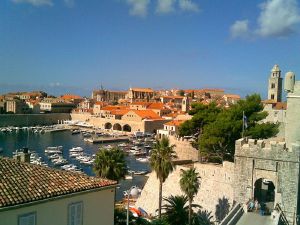
| |
| State Party | |
| Type | Cultural |
| Criteria | i, iii, iv |
| Reference | 95 |
| Region** | Europe and North America |
| Inscription history | |
| Inscription | 1979 (3rd Session) |
| Extensions | 1994 |
| Endangered | 1991-1998 |
| * Name as inscribed on World Heritage List. ** Region as classified by UNESCO. | |
Images
Panorama
Gallery
- Orlando, Dubrovnik, Croatia.JPG
The Orlando statue, symbol of a free city
- Dubrovnik walls.JPG
Dubrovnik as seen from its wall
ReferencesISBN links support NWE through referral fees
- ↑ Croatia Traveller, Dubrovnik
- ↑ City of Dubrovnik. Dubrovnik.hr. Accessed on July 2, 2007
- ↑ Dubrovnik. History.com Encyclopedia. Accessed on July 2, 2007
Further reading
- Dubrovnik. 2007. Everyman mapguides. London: Everyman. ISBN 9781841592626
- Dubrovnik. 2006. Insight pocket guide. Singapore: APA.ISBN 9789812583222
- Carter, Francis W. 1972. Dubrovnik (Ragusa): a classic city-state. London: Seminar Press. ISBN 9780128129500
- Harris, Robin. 2003. Dubrovnik: a history. London: Saqi. ISBN 9780863563324
- Kremenjas-Danicic, Adriana. 2006. Roland's European Paths. Dubrovnik: Europski dom Dubrovnik. ISBN 953-95338-0-5
- McKelvie, Robin, and Jenny McKelvie. 2006. Dubrovnik & the Dalmatian coast. DK eyewitness top 10 travel guides. London: DK. ISBN 9780756615536
- Stuard, Susan Mosher. 1992. A state of deference: Ragusa/Dubrovnik in the medieval centuries. Middle Ages series. Philadelphia: University of Pennsylvania Press. ISBN 9780812231786
External links
- Encyclopaedia Britannica Dubrovnik Retrieved September 17, 2008.
- World Fact Book 2008 Croatia Retrieved September 17, 2008.
- Dubrovnik, Croatia BBC World Weather, retrieved September 17, 2008.
- Old City of Dubrovnik UNESCO World Heritage Center, retrieved September 19, 2008.
- Dubrovnik picture gallery Croatia-official.com, retrieved September 19, 2008.
- Dubrovnik Map Retrieved September 19, 2008.
Credits
New World Encyclopedia writers and editors rewrote and completed the Wikipedia article in accordance with New World Encyclopedia standards. This article abides by terms of the Creative Commons CC-by-sa 3.0 License (CC-by-sa), which may be used and disseminated with proper attribution. Credit is due under the terms of this license that can reference both the New World Encyclopedia contributors and the selfless volunteer contributors of the Wikimedia Foundation. To cite this article click here for a list of acceptable citing formats.The history of earlier contributions by wikipedians is accessible to researchers here:
The history of this article since it was imported to New World Encyclopedia:
Note: Some restrictions may apply to use of individual images which are separately licensed.

